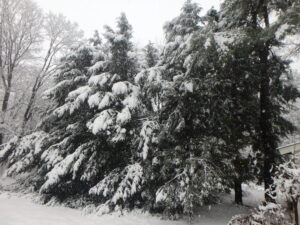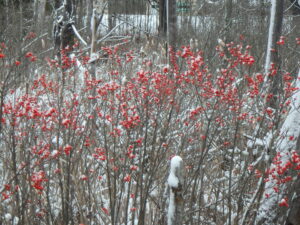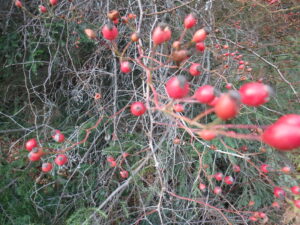Feeding the Birds – Naturally
Posted on Wednesday, December 9, 2020 · Leave a Comment
By now many of us are providing seeds to the neighborhood birds. Of course the seeds we provide are just a part of the diet of a wild bird. It’s important to grow a diverse selection of native trees, shrubs and perennials to help provide shelter and nesting places for our wild friends, and to provide food all year long. Why native? Native species evolved with the birds and they are genetically programmed to feed on them.
Doug Tallamy, an entomologist living in Pennsylvania, counted the number of butterflies and moth species that, as caterpillars, fed on an oak tree on his property. He counted over 400 species. He also counted species on a non-native shrub, burning bush ( Euonymus alatus), and found only one. The caterpillars of those butterflies and moths are what birds feed their babies each spring and summer, providing protein and fat needed for their development.
If you watch the birds at your bird feeder carefully now you will see that not only are many of the birds eating the seeds you provide, they are also nibbling things on the trees they perch on. In crevices in the bark are dormant insects and their larvae. Chickadees, nuthatches and woodpeckers – three of the most common birds at our feeders – are constantly pecking at bits of food.

Hemlocks provide shelter for our birds
There is a huge native cherry tree ( Prunus serotina) right by our feeders, a white pine and several Canadian hemlocks along with a couple of mature pear and apple trees nearby. The birds grab a seed at the feeder, zoom off to eat it and rest before returning. But while they are in those trees they almost always find something to tasty to peck at. Planting trees near your house and bird feeders is a good plan if you want to support your birds.
Fruit trees are great for your birds. Apple, pear and especially crabapple trees hold onto some fruit in winter. And while a chickadee might not tear into a dry and wizened apple, bigger birds do. I have seen turkeys feeding in a small weeping crabapple tree that could barely support them. Blue jays, crows, cardinals, grosbeaks and finches and other birds enjoy fruit in winter, too.
So what shrubs have edible fruit that is available to your birds in winter? Right now I see berries on cranberry bush viburnum (Viburnum opulus) and nannyberry (Viburnum lentago). Winterberry (Ilex verticillata), a native deciduous holly, produces myriads of bright red berries visible now in swamps and drainage ditches along the road. It is only eaten by a few birds, so the berries linger on into the winter – and are great for decorating wreaths. Junipers, a low-growing bush on low-fertility fields has berries now, too. Eaten by grouse, pheasants, grosbeaks and others, juniper berries are also used to flavor gin!

Winterberry grows best in wet places
Alders (Alnus spp.) generally are considered weedy and not planted in the landscape. They grow in wet places as large shrubs or small trees. They are nitrogen-fixing plants, and their seeds are eaten by sparrows and finches, among others. The seeds persist well into December.
Roses that bear fruit are important food sources, too. The invasive climbing wild multiflora roses (Rosa multiflora) are loved by birds, but they drop seeds which grow and take over and smother other shrubs and trees. Beach roses ( Rosa rugosa) produce lots of rose hips, and these are eaten by some birds. And although this species of rose is originally from Asia, it does not seem to take over the landscape the way multiflora roses do.

Multi flora rose hips are eaten by birds, but the plants are invasive and should be avoided
Of the big trees useful to birds, white pine (Pinus strobus) and Canadian hemlock (Tsuga canadensis) are two of the most important. Some 40 species of birds eat seeds of the white pine, and at least two dozen eat seeds of Canadian hemlock. Importantly, both are used in winter for shelter. They hold their leaves (needles), providing a break from cold winter winds. Both are used for nesting in the summer.
Any plant that holds onto its berries or seeds into winter is eventually eaten by birds. One of the small trees, staghorn sumac (Rhus hirta) is the least favorite of our birds. The red fruit generally is ignored until spring when returning robins and other migratory birds arrive when food is scarce. The fruit is sour and low in the fats that birds love, but a hungry robin will chow down on sumac if earthworms are not available. Sumacs grow mainly along roadsides in sandy, low-fertility soil. They spread by root and I don’t recommend planting them. But if you have some, leave them be if you can.

Alder catkins provide seeds now
Mentioned above as food for caterpillars that feed baby birds, oaks are important winter food sources, too. Acorns are a preferred food for turkeys and grouse, but can be cracked by a surprising number of small birds. Others eat the meat of acorns that are broken by cars or people, or clean out shells opened by large birds or mammals. Bears and squirrels love acorns, too.
Gray squirrels have been pirating my bird feeders, so I looked up on-line just how much they eat per day. Only a quarter of a cup of sunflower seeds per day will feed one, so I am letting the two portly, geriatric squirrels eat, and only chase them away if they get too greedy when my little chickadees are waiting.
Henry is offering one of his books, Organic Gardening (not just) in the Northeast, a Hands-On, Month-by-Month Guide as a holiday special for $15 including shipping. To get a signed copy, mail him a check at PO Box 364, Cornish Flat, NH 03746.